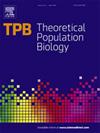Prevalence of social parasitism in ant populations: Modeling energetics, demography and space in the Polyergus/Formica system
IF 1.3
4区 生物学
Q4 ECOLOGY
引用次数: 0
Abstract
Obligatory interspecific brood raiding is a unique form of parasitism in which one ant species steals pupae from another species and raises them into workers to perform duties within its nest. Although this strategy can support very large colonies, the relative species abundance of these social parasites is always low. Using fully parameterized mathematical models of the growth and reproduction of the well-studied interaction between brood raider Polyergus and its hosts in the genus Formica, we aim to discover the mechanisms that limit brood raider abundance. These mathematical models explain the range of observed relative species abundance of these social parasites and provide a criterion for Polyergus persistence within a patch of hosts. In particular, Polyergus colony survival depends on the number of host colonies between 23 and 73 meters from their nest—close enough to raid but distant enough to survive raiding. The number sets the upper bound of Polyergus abundance to be less than 10% of the community. Furthermore, we quantify the fitness costs imposed by brood raiding on nearby host colonies, which can be effectively castrated by the constant drain on their worker resources. These findings provide a mechanistic framework for understanding the ecological constraints on social parasitism, its role in shaping ant community dynamics and its connection to the evolution of host defense strategies.
蚁群中社会寄生性的流行:Polyergus/Formica系统的能量学、人口学和空间建模。
强制性的种间寄生是一种独特的寄生形式,一种蚂蚁从另一种蚂蚁那里窃取蛹,并将它们培养成工蚁,在巢中履行职责。虽然这种策略可以支持非常大的群体,但这些群居寄生虫的相对物种丰度总是很低。利用已被充分研究的胶木属掠巢虫与寄主之间相互作用的全参数化数学模型,我们旨在发现限制掠巢虫丰度的机制。这些数学模型解释了观察到的这些群居寄生虫相对物种丰度的范围,并为聚螨在一个寄主斑块内的持久性提供了一个标准。特别是,波利格斯蚁群的生存取决于距离它们巢穴23米到73米之间的寄主蚁群的数量——近到足以发动袭击,但远到足以在袭击中幸存。这一数字表明,水蛭丰度的上限小于群落的10%。此外,我们还量化了蜂群突袭对附近寄主群体造成的适应性成本,这些寄主群体可以通过不断消耗工蜂资源而有效地阉割。这些发现为理解社会寄生的生态限制、其在塑造蚂蚁群落动态中的作用及其与宿主防御策略进化的联系提供了一个机制框架。
本文章由计算机程序翻译,如有差异,请以英文原文为准。
求助全文
约1分钟内获得全文
求助全文
来源期刊

Theoretical Population Biology
生物-进化生物学
CiteScore
2.50
自引率
14.30%
发文量
43
审稿时长
6-12 weeks
期刊介绍:
An interdisciplinary journal, Theoretical Population Biology presents articles on theoretical aspects of the biology of populations, particularly in the areas of demography, ecology, epidemiology, evolution, and genetics. Emphasis is on the development of mathematical theory and models that enhance the understanding of biological phenomena.
Articles highlight the motivation and significance of the work for advancing progress in biology, relying on a substantial mathematical effort to obtain biological insight. The journal also presents empirical results and computational and statistical methods directly impinging on theoretical problems in population biology.
 求助内容:
求助内容: 应助结果提醒方式:
应助结果提醒方式:


